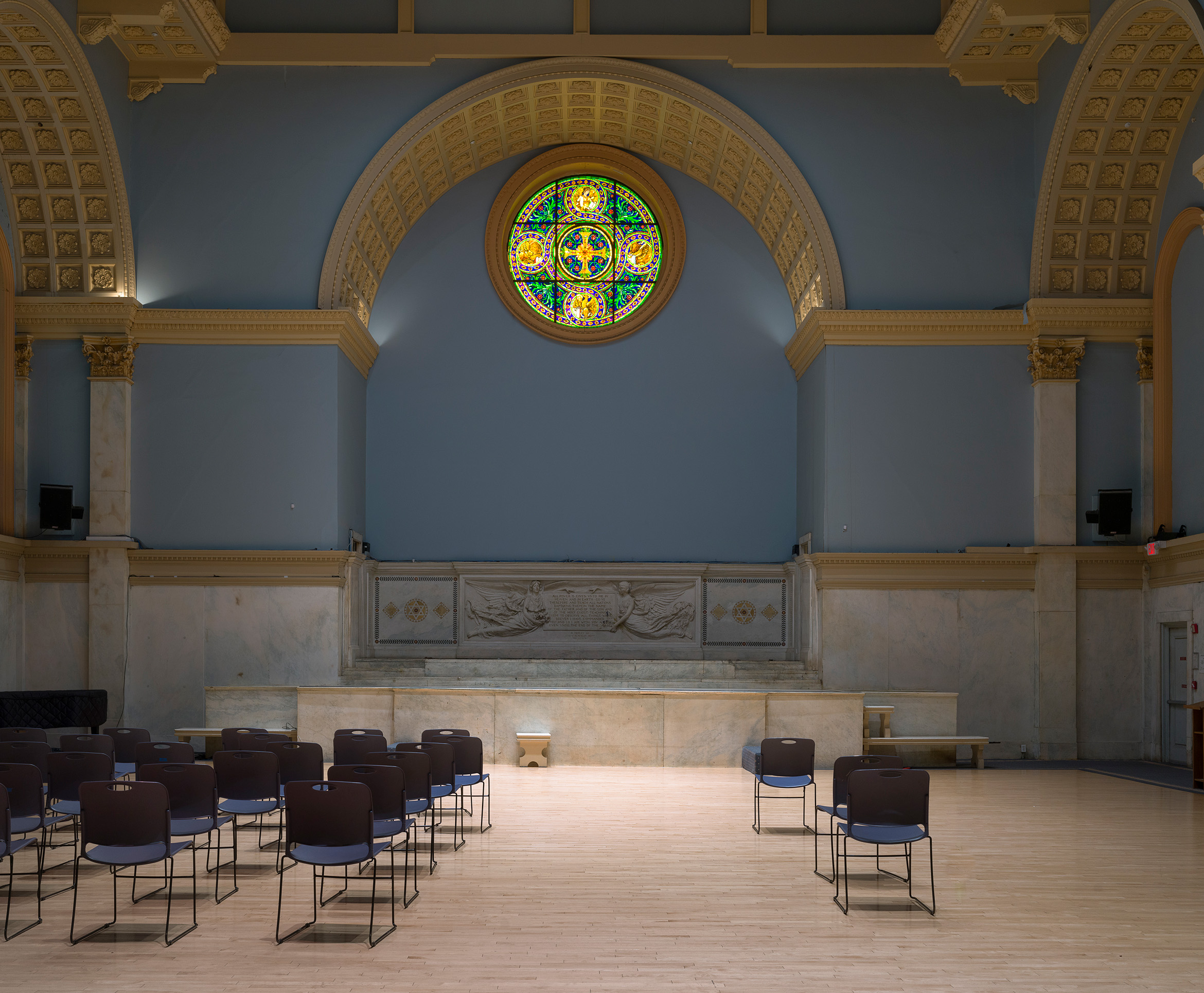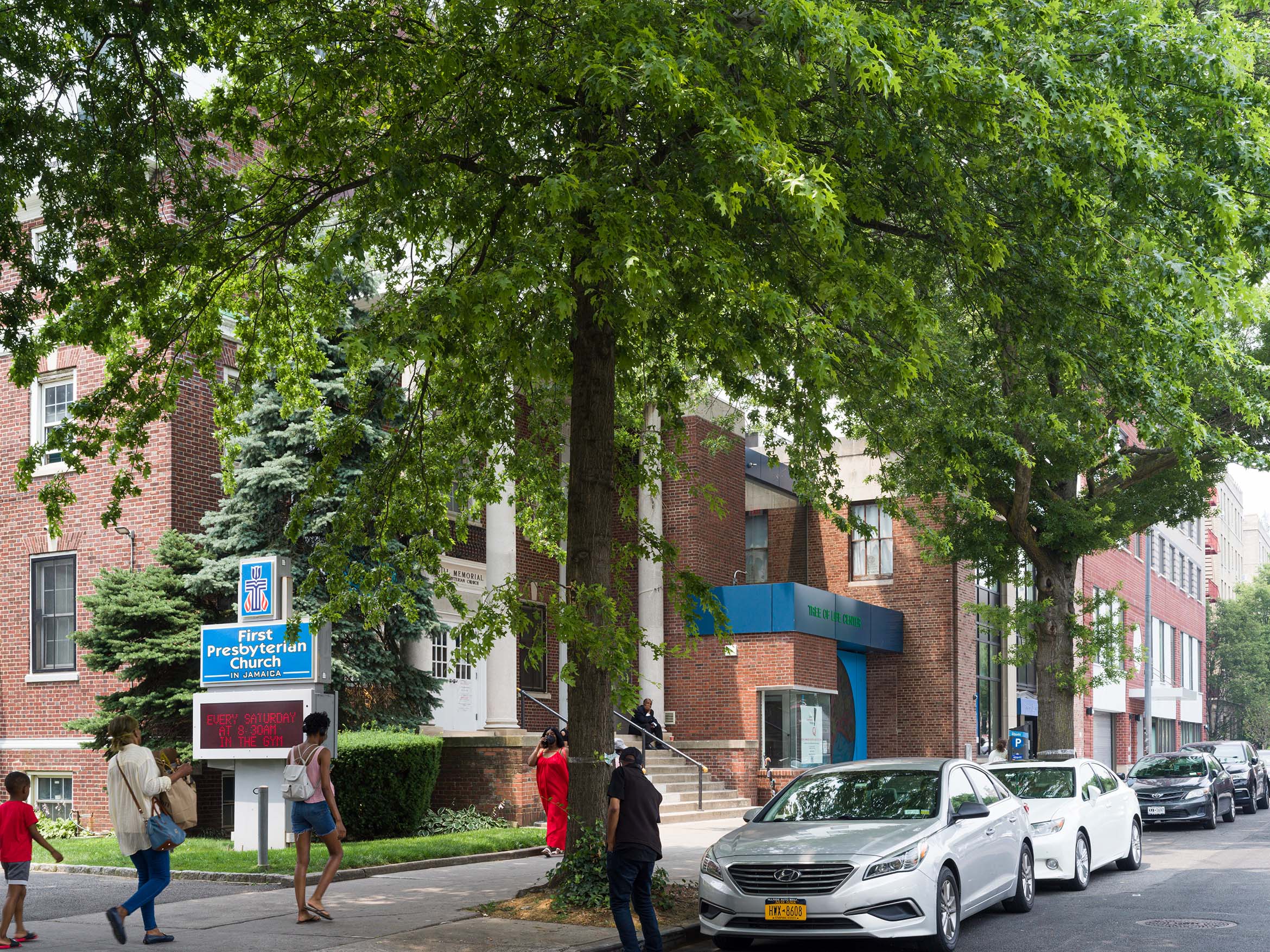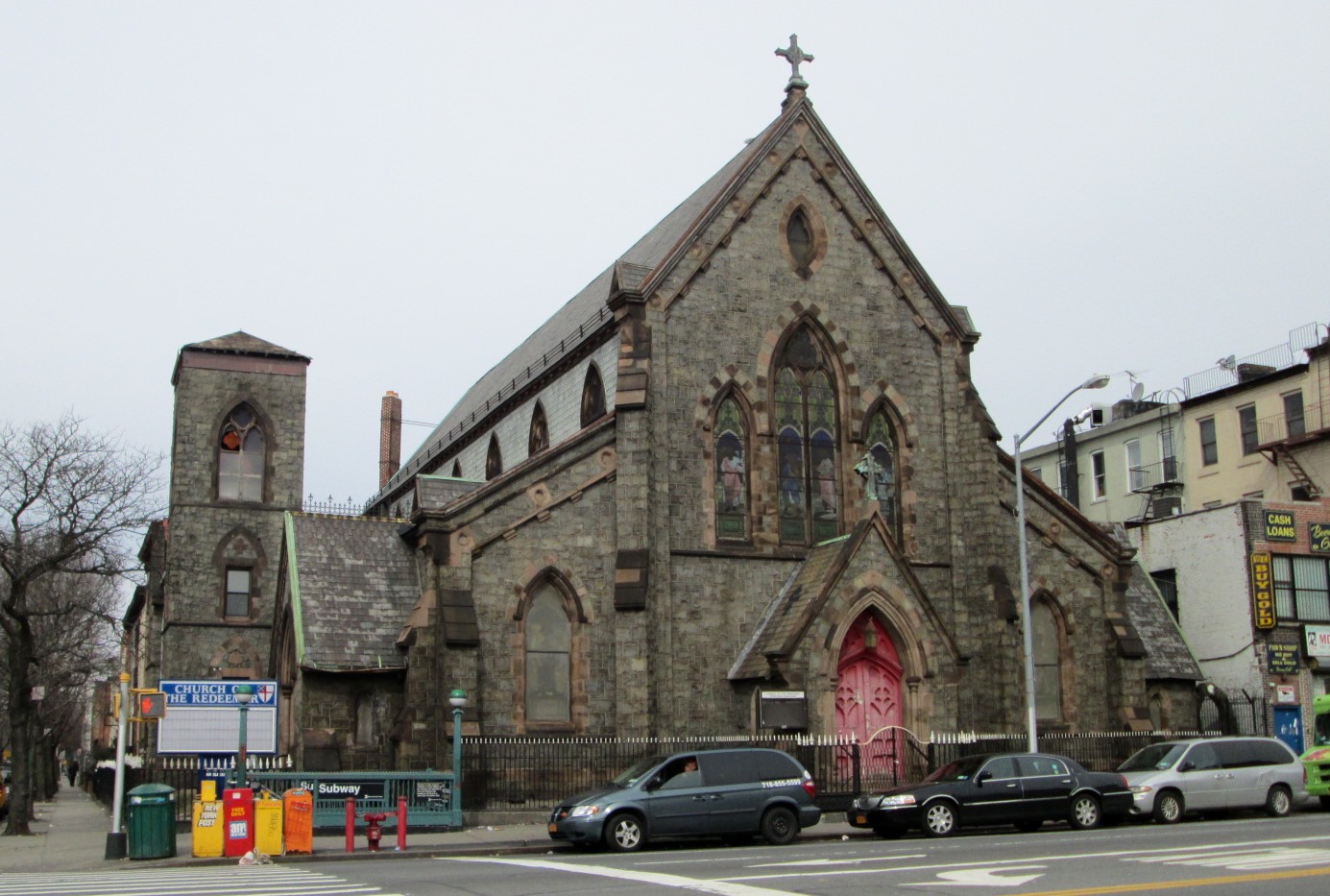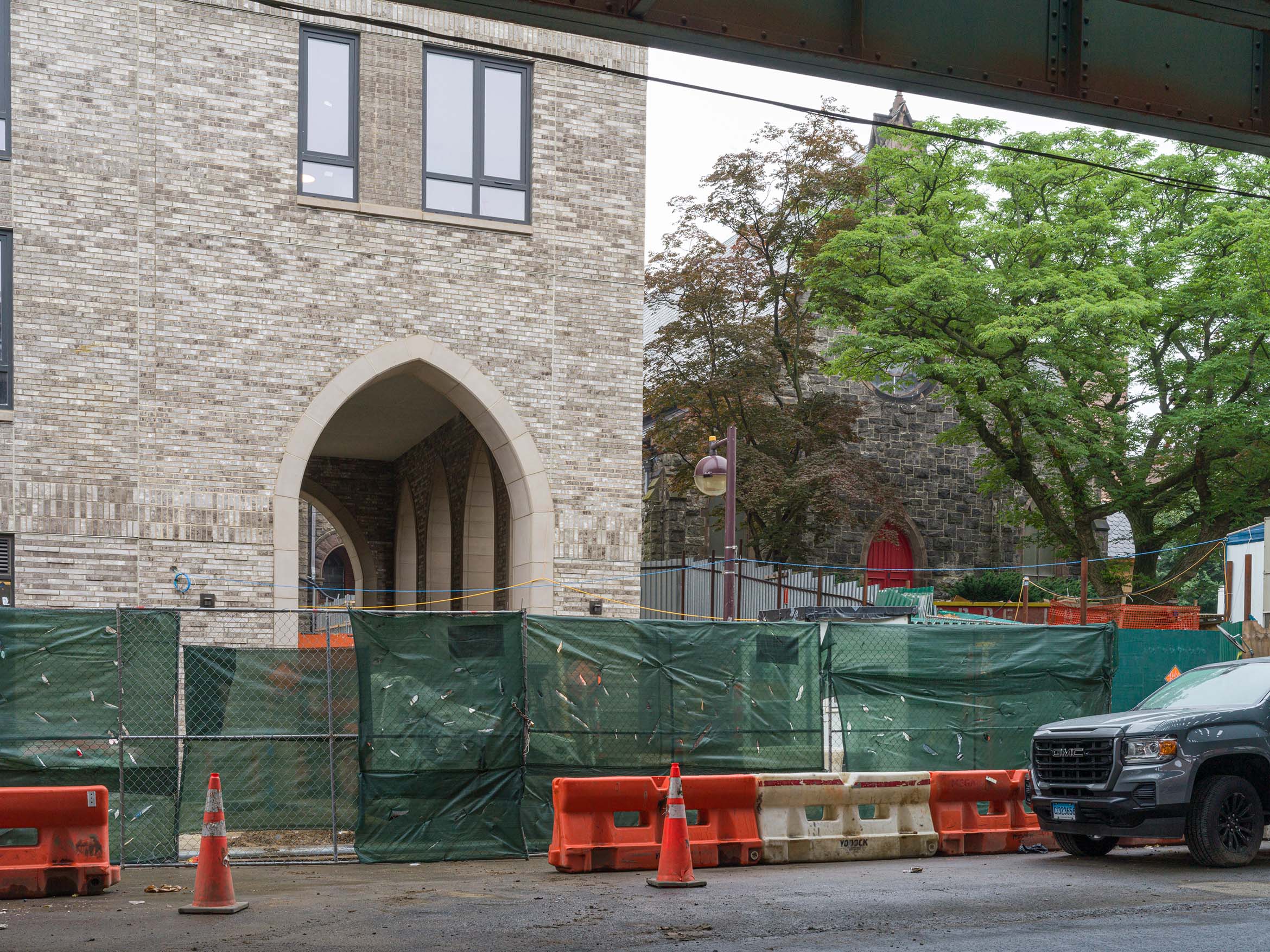
We are celebrating 15 years — and counting — of stories that are deeply researched and deeply felt, that build a historical record of what the city has been.
We are celebrating 15 years — and counting — of stories that are deeply researched and deeply felt, that build a historical record of what the city has been.
New York City’s churches, synagogues, mosques, temples, and other religious institutions own over 70 million square feet of real estate. Their spires and domed roofs are a memorable piece of the city’s landscape. In New York State, where 63 percent of people attend at least some religious services throughout the year, houses of faith impact the daily lives even of those who do not enter for prayer or worship. In many neighborhoods, these institutions are amongst the most trusted and competent social service providers. They run not just food pantries and soup kitchens, but also provide emergency housing, present arts programs, and accompany people to immigration hearings.
But for all the support they provide to those in need, many houses of worship are themselves struggling. Real estate developers regularly knock on the doors of faith-based organizations, hoping to purchase the building from a congregation that may not realize the full worth of their real estate holdings. The demolition of the beloved neighborhood landmark is a well-worn New York City story. But such narratives are only the beginning when it comes to the quandaries of faith-based real estate. Especially for aging Protestant congregations, membership rolls and revenues are shrinking at the same time that their historic buildings are coming to need expensive repairs and upkeep that they simply cannot afford — creating a deferred maintenance ouroboros. And as gentrification pushes working-class communities of color out of their neighborhoods, houses of worship find that their flock faces longer and longer commutes to attend. Many once faithful parishioners stop attending at all. Meanwhile, growing congregations (generally from non-Christian traditions and/or communities of color) struggle to find affordable worship space in the context of a real estate market that favors higher-paying secular tenants. In the face of so many real estate problems, houses of worship need workable — and theologically-informed — solutions. Here to help is the fledgling non-profit Bricks & Mortals, a network of faith leaders and real estate professionals supporting communities of faith navigating real property issues in New York City. We spoke with their executive director, Kate Toth, on how they work with faith communities on everything from tackling building code violations to developing affordable housing.
What led to the founding of Bricks and Mortals?
It’s well-known now in the faith community that membership for many houses of worship is declining. About ten years ago, at the time of the first conversations that would lead to our founding, it wasn’t as well-known. Throughout New York City, denominations and people working with them saw that this was happening. A lot of churches were being bought, especially in gentrifying neighborhoods. Faith communities across denominations and the real estate professionals who, by and large, worked with them on a daily basis and saw the same things coming up all the time, came together to figure out what was going on. The first thing they really talked about was, “What is happening? Is it just something that’s going on within my denomination? Is this happening in one part of the city?” They also realized that no organization existed in New York to really support those faith communities and what they needed in terms of real estate.
What are some of the programs you offer to support faith communities?
We work hand-in-glove with denominations to support their capacity and find out from them what they need more support on. We work with folks on compliance questions, which end up stymying a lot of congregations; getting their yearly tax-exemption and DEP-exemption status; and changes in regulations, which is helpful even for higher-capacity congregations. One example is Local Law 97, because that applies to congregations with higher square footage. We do one-on-one consultations, looking at specific issues, like a retaining wall, or if they’re having trouble figuring out how to make a payment on something, or dealing with one agency, or something broader, looking at systemic issues, through the policy work we do.
Could you give a sense of the scale of religious communities and the role they play in New York City today?
There are around 5,600 houses of faith throughout New York; we estimate 72 million square feet of land that their properties are on, not including their unused development potential. Each of these houses of faith really serves its own little micro-neighborhood. One important study that gives some insight into this is Partners for Sacred Places and University of Pennsylvania’s Economic Halo Effect study, which says that the average urban sacred site has an economic impact of $1.7 million per year; many in New York have many times more than that. The other number that I find interesting that comes out of that study is that 87 percent of the people who benefit from the services that houses of faith provide are not people that go to that congregation for religious services.
Typically, when people think about houses of faith, they think about food pantries, food banks, or Alcoholics Anonymous meetings. Those are the hallmark services that houses of faith provide. Houses of faith also provide space-sharing with many kinds of community groups: community organizing, or arts groups like the local theater or choir. Houses of worship are not doing this to make a profit. Part of it is to help pay their bills and diversify their income, but it’s also to use the space during this downtime and to support the mission of their congregation, which is to serve their community and to serve vulnerable communities. The space that they have for rent is often available to the public for below market rates.
Sometimes, a house of faith specializes in one area: they’re looking to help women and girls, or unhoused people. But often, they’re just opening their doors and have a variety of programs, and maybe a local nonprofit reaches out to them and wants to use their space to house it. There’s a study that says that houses of faith provide 40 percent of human services in major cities. I think that shows the secular impact the infrastructure that they have developed is having.
If these houses of faith close in their neighborhood, it’s not just the religious services that disappear, but the many social services they’re providing in that community. And if they go out of business, there’s going to be nothing that supports the community that comes in to replace them. Usually, it’s not replaced by a supermarket or something that might be a community asset in some other way. It’s replaced by a gentrifying element. It becomes a double negative for that community, they’ve lost this asset that’s a positive in many ways, but then it’s also something that’s detrimental to them in some other way.
You’ve spoken about the financial challenges many congregations are facing, which often are tied to owning and maintaining property. One difficult dynamic for some houses of faith is the cost of maintaining a landmarked building. Can you explain what landmarking means to houses of worship and what challenges it also brings to them?
An unintentional conflict exists in the Landmarks Preservation Law. Landmarking is meant to maintain the diversity of a neighborhood and support its economic development, but specifically for houses of faith, it can have the opposite impact.
Houses of faith are landmarked at 40 times the rate of the average New York City building. This makes sense — they’re often historic, beautiful, and made by renowned architects. If a commercial building is landmarked, and a new property owner takes on that building, they know the cost of maintaining that. If the past owner leaves that building, what the building offers to the community doesn’t go away with them. Whereas with the house of faith, if they need to change locations due to the cost of landmarking, the community actually is negatively impacted, which is the opposite of what landmarking is intending to do. It ends up being a no-win situation for everyone.
Some congregations pursue development on their property and sell some or all of their lot to a developer, who builds residential development. Can you share more about how houses of faith are thinking about making this development process mission-aligned?
A lot of congregations want to pursue affordable housing because of the scale of the need, in the city overall, but particularly in their own gentrifying neighborhoods. They’re seeing that need within their own congregations. They want to address that and think they have the property to do it.
Many houses of faith also need funding because of deferred maintenance. The thesis around which Bricks and Mortals was founded is that membership is decreasing, so their income is decreasing, and at the same time, congregations are in historic properties that are getting more costly to maintain, and often have upwards of five or six figures of deferred maintenance costs. One of the ways they’re trying to deal with that is by developing their property and creating housing on the top, and having their congregation on the bottom. This is a once-in-a-lifetime opportunity for them. They obviously can’t do that again ever again. That’s why it takes a long time to figure out what they’re doing, and they want to pursue it carefully.
Mayor Adams convened a meeting last June, where he brought together faith leaders looking at affordable housing and homelessness and how the faith community could respond. I chaired the Mayor’s Working Group on Faith-Based Affordable Housing and Community Development that developed from this summit, and over the fall, we put together a plan with members of the faith community and people in the real estate community. The action plan has three subsections: affordable housing writ large, landmarks, and air rights. We provide specific examples about how policies might be changed, and how it could be structurally improved to be able to create more affordable housing and support the faith community in providing our services in New York.
The concept of being “able to” seems like an important caveat. Many congregations lack the capacity, both in terms of volunteer or staff time, and in terms of zoning or what would even be possible to build. In addition, many traditions have theologies that would discourage that sort of development — some may believe it inappropriate to tear down an existing house of worship, or have religious beliefs that would preclude them from using the interest-based financial instruments central to most housing development. How are houses of faith that are not pursuing property development finding ways to address this cash flow problem?
Space sharing can diversify the income of houses of faith, especially because they’re using it during the downtime, when the congregation wouldn’t be using the space. It doesn’t mean that it’s zero cost: there might be some costs because of trash or increased security. This past year, we worked with an NYU Wagner capstone class, and they created three versions of an equation for houses of faith to use to calculate a rent that takes into account all the expenses that might be incurred. But aside from those nuances, your property would be sitting empty otherwise, and you’d be heating and cooling it and losing money from that.
Bricks and Mortals is currently working on a space-sharing website for houses of worship, Venuely. Can you share more about that project?
I had thought about doing it when I started at Bricks and Mortals in 2019. And at that time, a space sharing platform existed that was somewhat serving this role for the users, not for houses of faith. But that platform and several other rental spaces all closed during Covid. I thought it was a good opportunity, especially because we get this request so much, that we developed a space-sharing website that was specifically designed for houses of faith to put their properties up and share their spaces. They make a page for each of the spaces they want to rent, and it gets synced automatically to their calendar. Once they upload all of the time slots available, the rules, the pricing, and all of those things, it runs pretty seamlessly. They just have to approve or decline rentals, and they have a choice about anyone that comes in their space.
This gives them both the expertise and the capacity to be able to do this. Higher-capacity congregations might have full-time staff that’s dedicated to this already, but this really opens the opportunity for many more congregations to start sharing their space with local artists, community groups, and other folks that are near them and need space. For congregations already sharing their space, Venuely streamlines the process, and provides analytics on how the space is used and by whom.
We’ve been talking to arts foundations about the impact this could have for artists in New York, and how many thousands and thousands of hours of rental space this can make available. There’s a lot of potential.
Especially because houses of faith are dispersed throughout all New York City neighborhoods, whereas dedicated rehearsal space for performing artists is especially concentrated in a few places, like Midtown Manhattan or Long Island City, this seems like a real benefit for artists who largely don’t live near these spaces.
That was one of the things that we heard. Many people want somewhere that’s close to their house, and often, people don’t live where the rehearsal spaces are, and existing rehearsal space tends to be expensive. They want to know what the place down the block from them, that’s five minutes from them, is renting. It’s really a matter of just matching them together and creating that opportunity. We’re off to a good start, and we’re getting congregations up and will soon start pivoting to invite the renters to join. We want to make sure there’s enough property there, so that when they search for space, many options come up.
We also just expanded to Indiana and New Jersey. We had planned to pilot it just in New York City. But once we got press on it, tons of people outside of New York contacted us.
We’ve been talking a lot about this paradigm of older, shrinking congregations. But there are also communities that are growing, mostly in non-Christian denominations and immigrant communities. Can you share a bit about what sorts of real estate problems or questions they have?
That kind of shift is very common throughout history. Worship spaces often transition between different faith communities. I think that just continues today, and that’s one of the things that we try to do. Venuely is for short-term rentals, but we also have a real estate swap list that we run to try to encourage these kinds of swaps. Because with a space that was built for worship, you don’t have to change too much if the faith changes.
When Bricks and Mortals was first founded, it was just targeting members with faith-owned property. After I was there for six months, we expanded the mission to include faith communities that were interested in acquiring property. They might be on the way to acquiring, but might not be there yet, or are in non-traditional worship spaces, like residences and other things like that. We want to make sure that we’re getting the resources to the people who really need them. One way to do that is by targeting not just the people who have had property for centuries.
Another issue which continues to come up is security. I would say that’s true for maybe for every community. But primarily, we hear it from Muslim and Jewish communities, wanting to see content about security for their houses of faith. There have been, on the federal level and state level, grants that were just launched in the past year or two that are specifically for this issue.
I’ve heard you say this many times in presentations, that Bricks and Mortals is looking to provide resources and capacity building, not to promote one outcome. What does it mean to be “outcomes neutral,” and why is that the ethos of this organization?
We’re there to help people make more informed and better decisions about what to do with their property. From there, it’s up to them. If they want to sell their property, they should be able to get the most money possible for that property. If they decide to keep their property, they should know how to do that too. We don’t recommend one consultant or contractor over another. If someone asked for an architect, we would give a list of every architect that’s a member; we don’t give our opinion about which is the best or work exclusively with one. We are trying to give folks options and the capacity to make an informed choice. We’re not an affordable housing organization, though we do help people do affordable housing. We’re not a space sharing organization, though we help people do that too. There’s no one size fits all approach. We’re the only one out there that’s not trying to push folks into one eventuality and just give outcome-neutral, unbiased advice without asking for a fee for our opinion. Every congregation really has to be dealt with as its own case.
All photos copyright Jade Doskow unless otherwise noted.
Urban Omnibus’s managing editor, Kevin Ritter, who conducted this interview, formerly worked as a project manager for Bricks and Mortals.
The views expressed here are those of the authors only and do not reflect the position of The Architectural League of New York.



